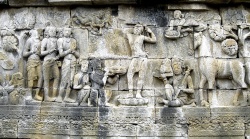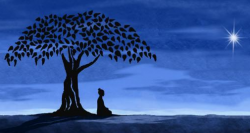Agganna Sutta: The Beginning of Humankind
<poem> Those who had studied the Pali Canon know that our ancestors were asexual – no sex differentiation. If any dhamma teacher said, men are superior to women, and then his study of the Pali Canon is in question. Buddha said to Mahapajapati Gotami said it all: Pajapati Gotami, go display your six supernatural powers to prove to some ignorant men that woman could also attained the arahatship. Let all five hundred sakyan princesses do the same. Yet, still today, there are some in Theravada Bhikkhu and householders who say:
To be born a woman in this life is due to her bad past kamma;
Bhikkhuni is the enemy of the Sangha order.
The Buddhist Cosmology that was described in Agganna Sutta, this world we live in today has gone through several cycles of expansion and contraction. It is hard for any one to say when the world began and when it will end. Some male Buddhists say men are superior to women; they are those who have not read the Agganna Sutta. :
In Agganna Sutta, Buddha said: look at how this world came into existence. In a snap shot, let us look the beginning of humankind: this earth was just a dark piece of earth with no living creature at all... Everywhere there were the steam and simmering earth emitting fragrance. Then one day the Brahmas from the Abhassara Brahmas world came down to visit the earth. Their radiance bodies act as light source and they explore the earth. There was no day light then. The Abhassara Brahmas are all asexual, - no male and female distinction. Knowing that mankind began with asexual, there was no sex differentiation – no men and no women. This was how our ancestors started as asexual being. (Abhassara Brahmas are asexual).
That was how our ancestor started; the beginning known as world contraction, the human ancestry started with the living beings born from the Abhassara Brahmas. Out of curiosity the Abhassara Brahmas fed on the scum of earth to test the flavor. After some long period feeding on the earth soils, the Brahma lost their body radiance. The earth was in total darkness. Then, the sun and moon started to appear in the firmament to start day and night time on earth. Then, every one looks the same; there was no gender, only asexual. Later, after some long period, sex organs were formed on their body. And the women became excessively preoccupied with the men, and the men with the women. Owing to this excessive preoccupation with each other, passion was aroused, and their bodies burnt with lust. And later because of this burning passion, they indulged in sexual activity. Trees appeared and rice was available freely.
This was what our Lord Buddha said as documented in Pali Canon and Abhidhamma. This was how our mankind started. This was the Buddhist view on the evolution of mankind. So was the earth that has gone through the contraction and expansion. This earth has gone through the destruction by fire, rain and wind and to escape from the destruction, people started to practice Samantha Bhavana to get to Abhassara Brahmas world. When the earth cooled down, the Abhassara Brahmas came down to earth and started the humankind.
Look at the Abhassara Brahmas World (rupa-loka)
In the Abhassara Brahmas world known also as (rupa-loka) there is no male and female distinction in this realm. They are all asexual - sexless and are made of pure radiance body. Without sex involvement, they live for a long, long time; their life span runs in up to 16,000 Maha Kalpas.
Look at the Devas in Kama Loka – sensual world.
The devas in the heavens of desire (karma loka), as in Tavatimsa or Tusita heavens, that have male and female distinction - meaning that these devas still have sex, they enjoy sensual pleasure in some what refined way compared to humans and animals.
Devas Living condition in Heavens
Those in the heaven of the four kings (Lokapala Nat Pyi) and the Tavatimsa simply let their spiritual energy mingle.
Those in the Yama heaven only need to go close to each other.
Those in Tusita heaven simply hold hands and
Those in the Nimmanarati heaven only have to look at each other!
These devas are constantly enjoying great sensual pleasures which are the fruits of their good kamma. Though their lives are relatively short (millions to billions of years) as compared to the Brahmas. Devas are also subject to aging and death.
When they are about to die, they first show the five minor signs of decay, followed by the five major signs, after which they will immediately fall to the lower realms. This applies to all devas in the heavens of form and desire alike. The five minor signs are:
1. They no longer hear divine music.2. Their radiance becomes diminished.3. Water start to wet their bodies.4. They start to miss the heavenly enjoyments.5. Their divine sight could no longer perceive the entire world.The five major signs are: 1. Their celestial robe becomes unclean.2. Their crown of flowers wilt.3. Sweat start to flow from their armpits.4. Their bodies start to smell.5. They start to become very agitated. In some way, it is difficult for devas to cultivate the Dhamma because the bliss or enjoyments in the heavens are so great that often devas don't think of the Dhamma until it is too late (when the five major signs of decay appear). Here I like to stop and think: in the Buddha First sermon - Dhammacakkappavattana Sutta - Dhamma sekkya Tayadaw – there were crores of Brahmas and Devas had attained higher knowledge and were liberated by listening to the Buddha first sermon. Was this due to their superior intelligence as Gods to understand and comprehend the dhamma?
In the human world, our life span is so short (less than 100 years), the law of impermanence, old age and death, is an every occurrence, it is true that the best condition to practice the Dhamma – to realize the law of Anicca, Dukkha, Anatta is much easier in human world.
So Buddha said, men and women both could attain the higher knowledge and he delivered the First Sermon for all, to practice the Sila-Samadhi-Panna – the Noble Eightfold Path. Buddha has proved to the world that women who are ordained like men to the Sangha order could attain the arahatship – liberation in this very life.


